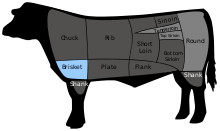Cooking for the Passover Seder: Brisket
Here we are, having just completed the Passover seder, drunk on red wine and dill-scented chicken soup. Due to the coronavirus, my wife and I are separated from the rest of our family and thus, for the first time, prepared the traditional Passover meal ourselves. Naturally, I wanted to start with the classics, charoset, chicken soup with matzo balls, and for the main event, brisket. Although we had never before made any of these dishes, I was confident in our likelihood of success for two reasons: first, I had watched Alison Roman do it and she made it look so easy in this 27-minute video, and second, I had an ace (well, two) up my sleeve.
I pulled the two quarts of bone broth out of my freezer, one beef, one chicken, and let them thaw out overnight in the refrigerator. Next I grabbed from the butcher case: one whole chicken and one brisket (1.5 pounds, which served two people generously), from the kosher-for-Passover end-cap: one small container of matzo meal, and from the produce aisle: parsley, dill, onion, garlic, carrot, and celery.
Aiming for a 9:00 o'clock dinner, I started cooking at 3:30. First order of business is the brisket. Coming from the lower portion of the cow's chest, just above the fore legs, where it supports more than half of the animal's weight—often over 1,000 pounds—the brisket is a heavily-worked cut, not suitable for a roast, grill, or sautée. It requires longer cooking methods, such as a braise or barbecue, to tenderize its tough muscle fibers. Since this is taking place in my New York City apartment on Passover, naturally I opted for the braise.

Braised meats have a special place in my heart. One reason for this is because I learned to cook through braising. Braised beef short ribs, from the Balthazar cookbook, was my first proper dish—excluding scrambled eggs and pasta from a box paired with sauce from a jar. Balthazar's 17-ingredient recipe is a beast, calling on the home cook to twine, brown, reduce, braise, and reduce some more. The result, however, was incredible and changed the way I viewed cooking forever. It immediately gave me the confidence and motivation to start cooking seriously—if you can make braised beef short ribs with a red wine reduction, then you can damn well cook (or even, do?) anything. What I didn't know then, but know now, is that all braises are essentially the same.
The first step in a braise is to brown the meat. In other words, let the meat come in direct contact with oil and heat in order to form a brown crust through the chemical process known as the Maillard reaction. This is particularly easy with brisket because it comes in one long piece, rather than many smaller, cube-like pieces (e.g. short ribs), which must brown on all sides, often in batches, to avoid crowding and thus steaming, and can take upwards of an hour to complete, depending on the size of pan and number of pieces. Virtually 100% of all modern recipes will call for a high-heat cooking oil such as canola oil ("Can-ada Oil," invented in 1970 at the University of Manitoba) or vegetable oil to get this job done. I strictly avoid these highly processed, inflammatory oils, for reasons covered in a separate post. Instead I use animal fats such as beef tallow, chicken fat, duck fat; or clarified butter (ghee); avocado oil; or even olive oil (non-extra-virgin works better than extra-virgin for browning, due to its higher smoke point--save the good stuff for salads). Whatever oil you use, be ready for the smoke alarm to go off. The fire department actually came to my house on my first attempt at the Balthazar recipe. This is not necessarily a sign that you're doing something wrong. High heat, sputtering oil, smoke: these are the realities of browning meat.
The second step in a braise is to cook the meat in a covered pot at a lower temperature while sitting in some liquid. While you could braise in water, that would be like having a latte with skim milk. Braising should always be done in broth or stock—the difference between the two will be discussed in a later post. Aside from the obvious flavor benefit of cooking meat in the savory broth derived from the bones of that animal, the gelatin contained in said broth lends an ethereal texture to your finished product that cannot be replicated in any other dish.
Braised meats necessarily start out tough and require 4+ hours of cooking to transform into the soft, falling-off-the-bone textures they are famous for. This long, slow process of transformation is perhaps my favorite thing about braising. While I love to grill, and to eat grilled meats, that process just doesn't offer the same satisfaction that you get from a lengthy braise. This also gives us ample time to get the rest of the Passover meal ready.
Ingredients
|
1. Preheat oven to 350°F. Sprinkle salt, pepper, paprika, and oregano on both sides of brisket.



